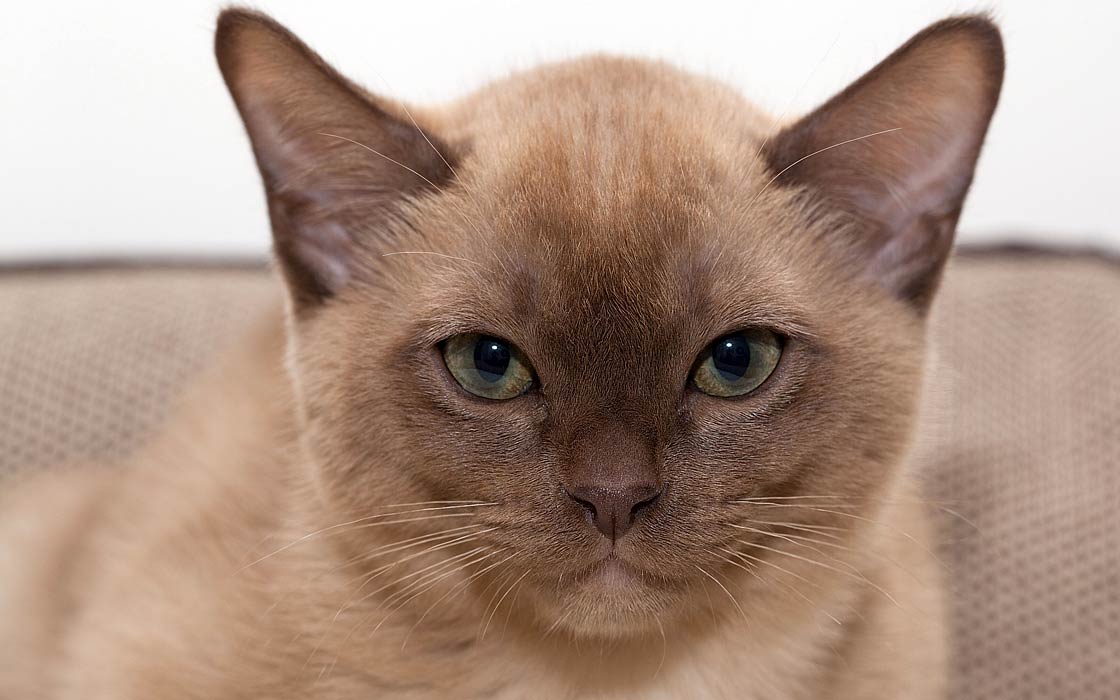Burmese cat
The Burmese cat from distant Asia is one of the most popular breeds today. In addition to its beautiful appearance, this cat also has a charming character. It is also not without reason that this race is sometimes called “a brick wrapped in silk”. If you want to know this reason and many other facts from the life of a Burmese cat, read the article.
FIFe classification
- Category III: Shorthair and Somali cats
- EMS code: BUR
- Country of Origin: Burma

History of the breed
References to cats resembling the contemporary Burmese cat come from the Thai book of poetry, which consists of 17 illustrated poems. This work was created in the Ayutthaya period (14th-15th centuries). This book mentions three types of cats, known today as Siamese, Korat and Burmese. The above-mentioned breeds lived for centuries only in the areas of today’s Thailand, until the Burmese invasion. In the 18th century, soldiers returning from the front took with them temple cats, known today as Burmese.
A pair of Siamese cats resembling modern Burmese and Tonkinese cats were presented at an exhibition at Crystal Palace in 1871. The deliberate breeding of these exotic animals, however, began in the late 19th century in Great Britain. In the beginning, they were called Chocolate Siamese; therefore they were not classified as a separate breed.

Recreation of the breed
This view persisted over the years, leading to mass crosses of Burmese and Siamese cats, thus trying to resemble the former to their Siamese relatives. As a result of these actions, the breed slowly became extinct in Great Britain.
In the 1930s, Dr. Joseph G. Thompson imported a chocolate female cat from Burma, whom he named Wong Mau. At first it was considered a new variety of the Malay breed, but over time it turned out to be the Tonkinese breed (a cross between the Siamese and Burmese breeds).
Since no male cat similar to her was found in the USA, a retired doctor decided to bring him from Thailand. A male named Tai Mau became the father of Wong Mau’s kittens. Some of them looked more like the mother, but a few were very much like Siamese. To get a dark brown color, Thompson decided to cross Wong Mau with her son – Yen Yen. This kinship mating gave rise to a desirable new breed – the Burmese cat.
Mass breeding of Burmese cats began in 1936, but was suspended 11 years later, as breeders continued to use Siamese cats to produce them. The trial resumed in 1953, and the breed is still very popular today.

Characteristic
Appearance
There are two breed standards that differ in the shape of the head and silhouette:
British variety
Also called traditional, it has a slender body, wedge-shaped head, large, pointed ears, a narrow snout and medium-sized, almond-shaped eyes. The silhouette is crowned with a tail tapering towards the end.
American variety
Also known as contemporary, it is distinguished by a stocky body, wide head, round eyes and a shorter, flattened face. The ears are wide at the base and the limbs and tail are in proportion to the length of the body.

“A brick wrapped in silk”
Both varieties, however, are relatively small, weighing 4-6 kg (8.8 – 13.2 lb). Many individuals, especially those of the American variety, however, have a very stocky body, thanks to which the weight is much greater, although the size of the body does not indicate it. For this reason, Burmese cats are sometimes referred to as “a brick wrapped in silk”.
The original Burmese breed had a dark brown (swarthy) color. Today, however, these cats are found in a variety of colors, including blue, platinum and champagne. The eyes may be gold or yellow.
The swarthy color is dominated by warm brown, only the underside of the body is lighter. The skin on the nose and paw pads is also brown. In champagne-colored cats, the underside of the body may sparkle with light gold or honey, the nose is dark brown, and the paw pads are light pink. The blue variety also has a lighter belly and chest, while the skin on the nose and pillows is ashen. In platinum Burmese cats, the nose and the skin on the underside of their paws acquire shades of lavender-pink.

Temperament
He inherited his personality from his Siamese ancestors who were full of charm, energy and friendliness towards people. He likes verbally contact with his owners. He shows a high level of intelligence and socialization, so he is not suitable for a home where he will be lonely most of the time. He does not only need people for companionship, in the absence of the owners, he will get along well with another cat or dog, although a friend ideal for a Burmese cat is usually … another Burmese cat.
When he shows up at home, he has to discover all its nooks and crannies, because he is very curious about the world, but also fun. Even in his adult life, he does not avoid antics. He loves to play with people and can also be taught various tricks.
Burmese cat wants to participate in every aspect of his owner’s life, so choosing him as our ward, we renounce a certain part of privacy. His love for the owner is also manifested in his willingness to sleep in a bed, lie on his lap, or right next to the owner. He needs affection, mainly frequent stroking, so low-feeling people should seriously consider the decision to adopt / buy him.

Detailed data / dimensions (size)
Burmese cat
- Height at the withers: 25-30 cm (9.8 – 12 in)
- Weight: 4-6 kg (8.8 – 13.2 lb)
- Lifespan: 10-17 years

Burmese cat – interesting facts
- The Burmese cat should not be confused with the Birman cat. They are two separate breeds, although they come from one geographical region – Myanmar (e.g. Burma).
- Some felinological federations take into account such Burmese cat’s colors as purple and red.
- Female Burmese cats have a very regal disposition, because they want to always be the center of attention. Males, on the other hand, are much calmer.
- Within the breed, diabetes and FCKS – a syndrome occurring in kittens – are relatively common. It is manifested by chest compression caused by deformities of the spine. Some scientists believe that FCKS occurs extremely often in Burmese cats. Research conducted in Great Britain in the 1980s neither confirmed nor refuted this hypothesis.



















